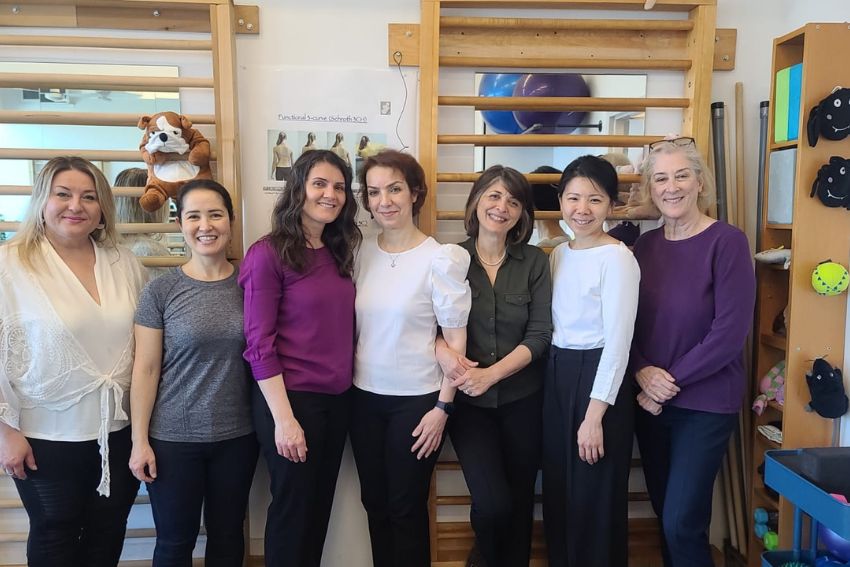Preparing for a first Scoliosis Intensive Rehab (SIR) group class can feel like a big step for both children and parents. This guide offers clear, research-based insights from our program to help both parents and children know what to expect and feel supported from the start.
Continue reading to learn,
- What is SIR? A quick overview
- Why does this group approach help?
- Who are the physiotherapists leading the group classes?
- Group class details
- Strong Beginnings: Why Assessments and 1:1 Sessions Are Essential
- Simple at-home preparation before the first class
- What to expect at the first SIR group class
- What benefits families will notice after a few classes
- Brief FAQs
- Ready for Your Next Steps
What is SIR? A quick overview
Scoliosis Intensive Rehab (SIR) is a caring, small-group program that uses Schroth-style exercise therapy to help children learn posture, breathing, and movement patterns that support their spine. These classes focus on safe, repeatable practice so kids and teenagers gain strength, flexibility and the confidence to manage scoliosis in their day-to-day life.

Why does this group approach help?
- For shared encouragement. Practicing with peers makes difficult movements feel more manageable. Children support one another and learn practical improvements together.
- For building confidence through repetition. SIR emphasizes repeated, curve-specific drills so skills become automatic; that practice helps them build confidence to take charge of their own care between classes.
- For therapeutic play. Playful activities (balance games, obstacle tasks, partner challenges) maintain focus and help children internalize posture corrections without stress. Therapeutic play also improves coordination and makes repetition of movement feel natural.
Who are the physiotherapists leading the group classes?

The sessions are led by experienced physiotherapists Irene and Vivian, with Fariba working closely on technique and individual feedback. They guide each child at a comfortable pace and adapt exercises as needed.
Group class details
- Format: small group classes (for personal attention within a group setting).
- Schedule: every other Saturday, multiple 1-hour classes between 9:30 AM and 1:30 PM.
- Location: Canada Scoliosis & Neuro Centre
- How to join (by appointment only),
Strong Beginnings: Why Assessments and 1:1 Sessions Are Essential

Before joining SIR, we ask families to complete an initial assessment and we recommend at least one private 1:1 Schroth session. This is preparation that keeps your child safe and helps them get the optimum results from the group classes.
What does the initial assessment do?
- Maps your child’s curve pattern and checks posture and their range of motion.
- Identifies any need for brace use or activity limits.
- Sets simple, realistic goals and recommends targeted exercises to start with.
What does our 1:1 Schroth session teach?
- Curve-specific breathing (the Schroth breathing techniques that help expand the rib cage).
- The basic scoliosis posture corrections and how to do them safely.
These private sessions build familiarity and reduce first-day anxiety so the group class is a comfortable next step.
Simple at-home preparation before the first class
A little practice helps your child step into class with confidence. Try short, daily items such as:
- Gentle mobility and exercise for scoliosis at home
- simple stretches
- core activations
- Posture reminders during
- sitting
- walking
- A two-or-three minute breathing practice to get used to guided breathing. For example
- Schroth-style lateral breaths
- Gentle mobility and exercise for scoliosis at home
During your child’s initial assessment and 1:1 sessions, our physiotherapists will guide you on the most suitable home activities, ensuring the practice is safe and tailored to your child’s needs.
What to expect at the first SIR group class
We keep the first session gentle and predictable so your child feels safe and engaged.
- Arrival & welcome: A quick check-in, short chat with the instructor, and a reminder of the child’s personal plan from the assessment.
- Warm-up & breathing: Simple movements and Schroth based lateral breathing to activate the core and rib mobility.
- Curve-focused exercises: Short, repeatable scoliosis back exercises tailored to each child’s curve pattern. These are taught step by step and adjusted to suit ability.
- Group practice: Interactive drills that encourage repetition and peer support. For younger children, these may look like playful balance tasks; for teens, more structured sets.
- Cool-down & home program: A short cool-down and a clear exercise home program to practice between classes. Instructors give a few focused tasks you can manage at home that are short, doable, and effective.
What benefits families will notice after a few classes
- Better posture awareness and comfort during daily activities.
- Increased muscle support around the curve. Especially, the muscles affected by scoliosis feel stronger and more reliable.
- Greater confidence from practicing with peers and from knowing what to do at home.
- Easier carryover of skills when the exercise home program is followed regularly.
Brief FAQs
Q: How long is each SIR class?
A: One hour. Classes run every other Saturday in the 9:30 AM–1:30 PM window.
Q: Is the initial assessment necessary?
A: Yes, it helps tailor the group program to your child’s curve and safety needs.
Q: Do private sessions mean my child is behind?
A: Not at all. One or two private sessions are recommended so your child learns the basics in a calm setting. It’s a confidence-builder, not a requirement of skill.
Ready for Your Next Steps
- Consider 1:1 Schroth sessions (1–2 short visits) to prepare for the group class
- Reserve your SIR group slot by:
Space is limited so families find it helpful to book the assessment first. That way the therapists can recommend the best 1-hour session time and confirm the right class for your child.
